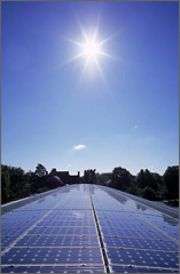Researchers are reporting record-high efficiency levels for a new generation of solar cells. Credit: National Renewable Energy Lab
Researchers in China and Switzerland are reporting the highest efficiency ever for a promising new genre of solar cells, which many scientists think offer the best hope for making the sun a mainstay source of energy in the future.
The photovoltaic cells, called dye-sensitized solar cells or Grätzel cells, could expand the use of solar energy for homes, businesses, and other practical applications, the scientists say. Their study is scheduled for the November 13 issue of ACS' The Journal of Physical Chemistry C.
The research, conducted by Peng Wang and colleagues — who include Michael Grätzel, inventor of the first dye-sensitized solar cell — involves photovoltaic cells composed of titanium dioxide and powerful light-harvesting dyes. Grätzel cells are less expensive than standard silicon-based solar cells and can be made into flexible sheets or coatings. Although promising, Grätzel cells until now have had serious drawbacks. They have not been efficient enough at converting light into electricity. And their performance dropped after relatively short exposures to sunlight.
In the new study, researchers describe lab tests of solar cells made with a new type of ruthenium-based dye that helps boost the light-harvesting ability. The new cells showed efficiencies as high as 10 percent, a record for this type of solar cell. The new cells also showed greater stability at high temperatures than previous formulas, retaining more than 90 percent of their initial output after 1,000 hours in full sunlight.
Article: "New Efficiency Records for Stable Dye-Sensitized Solar Cells with Low-Volatility and Ionic Liquid Electrolytes" dx.doi.org/10.1021/jp808018h
Source: American Chemical Society
























